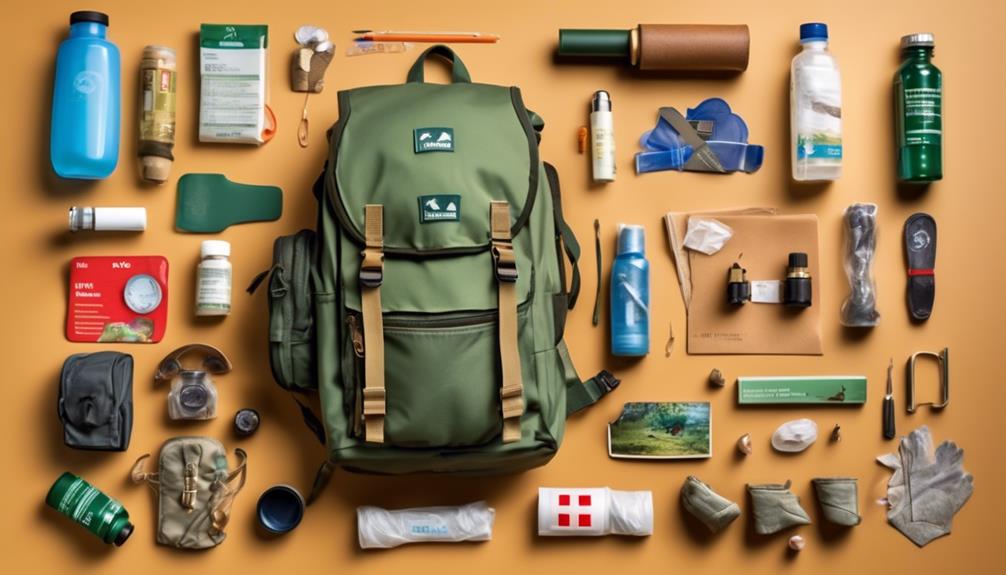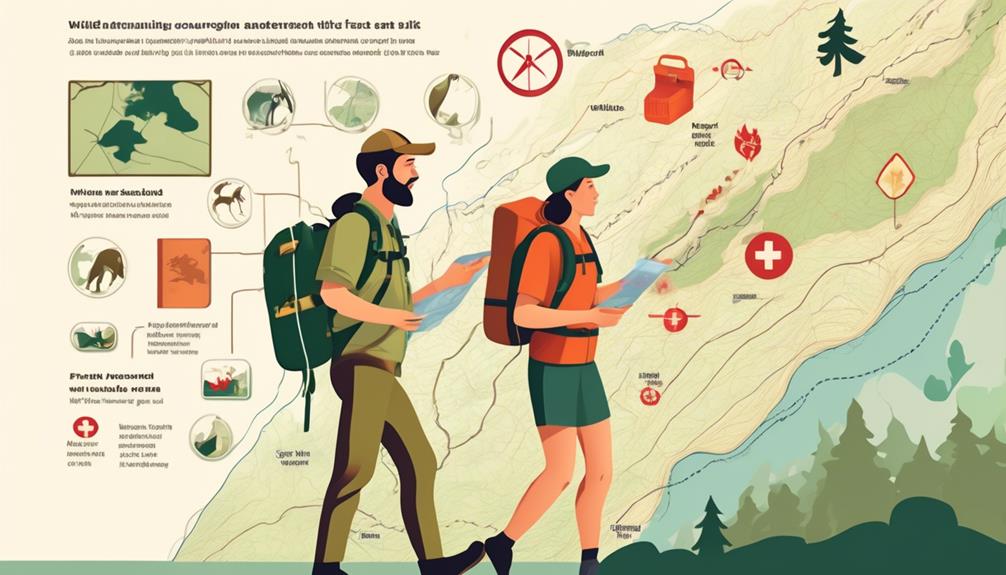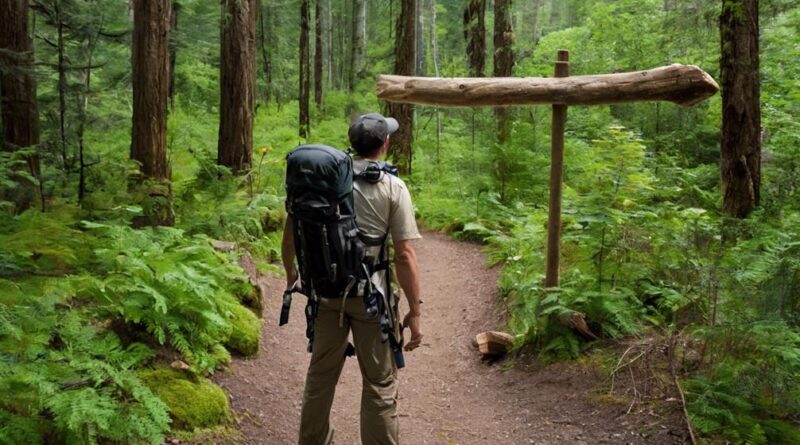Effective Preparation Guide for Wildlife Encounters
Are you prepared to encounter wildlife in their natural habitats? Whether you're a seasoned wildlife enthusiast or a beginner, there are crucial steps to take before venturing into the wild.
From understanding animal behavior to packing essential gear, the key to a successful and safe wildlife encounter lies in thorough preparation.
With potential encounters ranging from awe-inspiring to potentially dangerous, it's essential to equip yourself with the knowledge and tools necessary to navigate these encounters with confidence and respect.
Researching Wildlife Habitats
Before venturing into the wilderness, it's crucial to research the habitats of the wildlife you may encounter to ensure a safe and prepared experience. Wildlife observation and animal tracking are essential skills for any wildlife enthusiast. When researching wildlife habitats, focus on understanding the specific behaviors and preferred environments of the animals you hope to observe.
Start by consulting reliable field guides or websites that offer detailed information about the habitats, feeding patterns, and movement of the wildlife in the area you plan to visit.
Once you have a good understanding of the wildlife's habitats, plan your observations accordingly. Identify the best times of day or year to spot the animals and the specific locations where they're known to frequent. Pay attention to signs of animal presence such as tracks, droppings, and feeding areas. Understanding these cues will enhance your wildlife observation experience and increase your chances of successful animal tracking.
Additionally, consider the safety measures necessary when observing wildlife in their natural habitats. Some animals may be dangerous if approached too closely, so familiarize yourself with the appropriate distances for observation. Moreover, learn about any potential risks associated with the wildlife in the area, such as venomous snakes or predatory animals, and take necessary precautions.
Understanding Animal Behavior
When researching wildlife habitats, you'll gain valuable insights into the specific behaviors and preferred environments of the animals you hope to observe, enabling you to better understand animal behavior. Understanding animal behavior involves recognizing patterns of animal communication and interpreting predatory instincts.
Animal communication plays a crucial role in their social structure and survival. By observing vocalizations, body language, and other forms of communication, you can better comprehend their intentions and emotions. Predatory instincts are essential for animals' survival, and recognizing these behaviors can help you anticipate their actions and avoid potential dangers.
By understanding animal communication, you can interpret various signals such as warning calls, mating rituals, or distress signals. This knowledge allows you to approach wildlife encounters with caution and respect, minimizing the risk of startling or provoking the animals. Additionally, recognizing predatory instincts helps you to predict potential hunting behaviors and avoid inadvertently entering a predator's hunting territory.
Furthermore, understanding animal behavior also involves recognizing signs of distress or agitation. Animals may exhibit certain behaviors when feeling threatened or uncomfortable, and being able to identify these signs can prevent unnecessary stress to the animals and ensure your safety during wildlife encounters.
Packing Essential Gear

To ensure a successful wildlife encounter, pack essential gear that includes a sturdy backpack, appropriate clothing, and a reliable water bottle. Proper gear organization is vital for a smooth wildlife experience.
Start by choosing a sturdy backpack with compartments to keep your gear organized and easily accessible. This will allow you to quickly grab your wildlife photography equipment when an opportunity arises. Additionally, consider wearing appropriate clothing for the specific environment you'll be exploring. For wildlife photography, comfortable and camouflage clothing can help you blend into the surroundings, increasing your chances of capturing animals in their natural habitat without disturbing them.
When it comes to wildlife photography, packing essential gear such as a high-quality camera, extra lenses, and a tripod is crucial. Ensure that your camera and lenses are well-protected in the backpack with cushioning to prevent any damage during your outdoor activities.
A reliable water bottle is also a must-have item. Staying hydrated is essential, especially during extended periods of wildlife observation and photography.
Learning Wildlife Safety Tips
Ensure your wildlife encounter is both enjoyable and safe by learning essential wildlife safety tips that will complement your preparedness for the adventure. Firstly, honing animal tracking skills is crucial for understanding wildlife behavior and avoiding unexpected encounters. Learn to recognize signs of animal presence such as tracks, scat, and markings on trees to anticipate their movements and keep a safe distance. Additionally, understanding wildlife photography techniques can't only capture stunning moments but also ensure your safety. Practice using zoom lenses and remote triggers to maintain a safe distance while photographing wildlife in their natural habitat.
Moreover, it's important to be aware of wildlife conservation efforts and how they impact the animals you may encounter. Understanding the local conservation initiatives can provide insight into the behavior and patterns of the wildlife, ultimately contributing to a safer and more informed experience.
Furthermore, bird watching tips are essential for a safe and enjoyable encounter with avian species. Learn about the different species in the area, their habitats, and typical behaviors to appreciate them from a safe distance. Utilize binoculars and bird identification guides to observe these magnificent creatures without disturbing their natural routines.
Choosing Appropriate Clothing

As you prepare for wildlife encounters, selecting appropriate clothing that's both comfortable and functional is vital for your safety and enjoyment. When it comes to encountering wildlife, layering techniques are essential. Layering allows you to adjust your clothing according to the changing weather conditions and activity levels.
Start with a moisture-wicking base layer to keep sweat away from your body. Next, add an insulating layer to keep you warm, and finish with a waterproof and windproof outer layer to protect you from the elements.
In addition to layering, consider camouflage options when choosing your clothing. Camouflage can help you blend into your surroundings, making it easier to observe wildlife without disturbing them. When selecting camouflage clothing, ensure it's suitable for the specific environment you'll be in. For forested areas, opt for patterns with greens and browns, while desert environments may call for sandy or tan colors.
Remember to choose clothing that allows for ease of movement, as wildlife encounters often involve walking or hiking. Comfortable, sturdy footwear is crucial, especially if you plan on traversing uneven terrain. Additionally, consider clothing with built-in sun protection to shield yourself from harmful UV rays.
Obtaining Necessary Permits
Before embarking on any wildlife-related activities, ensure you have obtained all necessary permits from the relevant authorities. Permit application processes vary depending on the type of activity and the specific regulations of the area you plan to visit. It's crucial to familiarize yourself with these regulations and ensure compliance to avoid any legal issues during your wildlife encounters.
When it comes to permit application, the first step is to research the specific permits required for the activities you intend to pursue. This may include photography permits, camping permits, or permits for specific wildlife observation. Once you have identified the necessary permits, carefully review the application requirements and procedures. Some permits may require advance reservations or have limited availability, so it's advisable to start the application process well ahead of your planned visit.
Understanding permit regulations is equally important. Be sure to acquaint yourself with the rules and restrictions associated with each permit. These regulations may cover areas such as designated wildlife viewing zones, prohibited activities, and wildlife protection guidelines. Adhering to these regulations not only ensures your own safety but also contributes to the preservation of the natural habitat and its inhabitants.
Knowing Emergency Procedures

In case of encountering a wildlife emergency, promptly assess the situation and prioritize your safety and the well-being of the animals involved. Recognizing signs of distress or injury in wildlife is crucial. If you come across an injured animal, keep a safe distance and observe its behavior. Signs of distress may include unusual vocalizations, limping, or rapid breathing. It's essential to remain calm and not approach the animal, as it may become defensive or agitated. Instead, contact local wildlife authorities or animal rescue organizations for assistance.
Being prepared with basic animal first aid knowledge can also be beneficial in emergency situations. While administering first aid to wildlife should be left to professionals, having a basic understanding of how to safely approach and handle injured animals can make a difference. Always prioritize your safety and avoid putting yourself at risk when attempting to provide aid. In some cases, providing first aid may involve creating a safe space for the animal and minimizing external stressors until help arrives.
Remember that every wildlife encounter is unique, and it's important to avoid making assumptions about an animal's behavior or condition. In the event of a wildlife emergency, always seek guidance from experts and follow their instructions carefully. By being prepared and knowing the appropriate emergency procedures, you can help ensure the safety and well-being of both yourself and the wildlife involved.
Respecting Wildlife Boundaries
Respecting wildlife boundaries involves understanding and acknowledging the importance of maintaining a safe distance and minimizing disruption to their natural habitats. When engaging in wildlife observation, it's crucial to remember that wild animals need their space to thrive. By respecting wildlife boundaries, you not only ensure your safety but also contribute to conservation efforts.
When observing wildlife, always maintain a respectful distance. This not only minimizes the potential for disturbance but also protects both you and the animals. Approaching too closely can cause stress to wildlife, leading to altered behaviors or even aggressive responses. By keeping a safe distance, you can observe these creatures in their natural habitat without causing them undue stress.
Conservation efforts rely on our ability to respect wildlife boundaries. By minimizing our impact on their natural habitats, we can help preserve these environments for future generations. Disrupting wildlife through intrusive behavior can have lasting consequences on their well-being and the delicate balance of their ecosystems. Therefore, it's imperative to prioritize the well-being of the wildlife by respecting their boundaries.
Frequently Asked Questions
What Are Some Common Mistakes People Make When Approaching Wildlife in Their Natural Habitat?
When approaching wildlife in their natural habitat, common mistakes include getting too close, making sudden movements, and not respecting their space. Prioritize wildlife safety by learning proper approaching techniques, especially when engaging in wildlife photography.
Are There Any Specific Techniques for Photographing Wildlife Without Disturbing or Endangering Them?
When photographing wildlife, use a long lens to maintain a safe distance. Avoid using flash and sudden movements to avoid disturbing animals. Always prioritize wildlife preservation by respecting their space and natural behavior.
How Can I Tell the Difference Between a Harmless Animal and a Potentially Dangerous One?
When observing wildlife, identifying signs and behaviors is crucial for wildlife safety. Wildlife education and conservation efforts can also help distinguish harmless animals from potentially dangerous ones. Always prioritize safety and respect for wildlife.
What Should I Do if I Encounter Injured Wildlife While Out in the Wilderness?
If you encounter injured wildlife in the wilderness, first aid can help. Be cautious and contact wildlife rescue or conservation organizations. They can provide guidance on safe handling and help rehabilitate the animal for its eventual release back into the wild.
Are There Any Cultural or Ethical Considerations to Keep in Mind When Interacting With Wildlife in Different Regions of the World?
When interacting with wildlife in different regions, consider cultural sensitivities, wildlife conservation, ethical considerations, and environmental impact. Respect local customs and regulations, and prioritize the well-being of the wildlife and their natural habitat.
Conclusion
Now that you have all the necessary information and gear, you're ready to have a safe and enjoyable wildlife encounter.
Remember to respect the boundaries of the animals and their habitats, and always prioritize safety.
With the right preparation and knowledge, you can make the most of your wildlife experience while minimizing any potential risks.
Happy exploring!
